CAMPGROUNDS, PICNIC AREAS
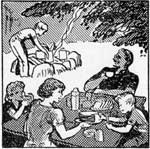 YOU MAY spread your lunch or pitch your tent almost anywhere you please in the national forests, but before doing so it is well to look over some of the 3,800-odd sites that have been specially selected and improved for picnickers' and campers' convenience and enjoyment.
YOU MAY spread your lunch or pitch your tent almost anywhere you please in the national forests, but before doing so it is well to look over some of the 3,800-odd sites that have been specially selected and improved for picnickers' and campers' convenience and enjoyment.
Free facilities include tables and benches, stove or masonry fireplaces, latrines, garbage receptacles, approved drinking water and, in some places, beaches with lifeguards, diving boards, bathhouses, parking areas, and community shelters.
No special permission for use of improved forest camp and picnic areas is necessary. But in some of the forests at certain 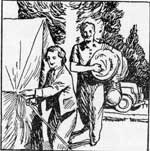 seasons, if one desires to go outside these designated areas it is necessary to obtain a campfire permit from the forest ranger before pitching camp or building a picnic fire. No charge is made for these permits.
seasons, if one desires to go outside these designated areas it is necessary to obtain a campfire permit from the forest ranger before pitching camp or building a picnic fire. No charge is made for these permits.
Picnic and campground accommodations provided in the national forests are sufficient to care for 240,000 people at one time. More popular areas have as many as 100,000 or more visitors each year; others have hardly 200 a year. Publicly owned and operated cabin camps are available in a few instances. A number of the campgrounds have special provisions for trailer parking, but there are many not so equipped.
A few national forest campgrounds are so popular it is necessary to limit the length of stay of each party. At such camps notices of time limits are posted in prominent places.
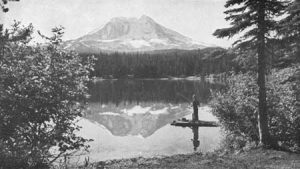
Fishing is good in national-forest waters.—Columbia National Forest, Wash. (F—356431)
Accessibility and Location.—Forest camps and picnic grounds are located in the most attractive surroundings the locality affords. They are found in the dense spruce and pine thickets of the Great Lakes region, at the edge of the Arizona desert amid fantastic cacti 40 feet high, on coast lines and lake shores where the surf pounds at the camper's feet, and high in the mountains where alpine flowers bloom at the edge of perpetual snowbanks. Shade, scenery, a forest environment, and proximity to recreation areas are advantages common to all of them.
The passing tourist would never know it except for the signs, but many well-screened forest campgrounds are within a stone's throw of arterial highways. On the other hand, others may be reached only by traveling the more intimate forest roads.
Campers are naturally expected to bring their own tents, bedding, cooking utensils, and food. Near many of the campgrounds are small-town stores where most of the needed staples can be obtained. However, many other campgrounds are miles from a source of supply. To avoid long, tedious trips for provisions, it is always best to take plenty of food at the outset, if going into out-of-the-way areas.
Some of the camps are open the year-round, others are usable only during the summer.
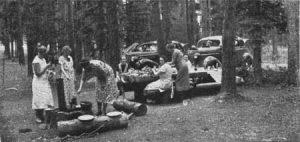
National-forest picnic grounds are widely used by family groups—Lewis and Clark National Forest, Mont. (F—350578)
Organization Camps.—For those who must get their vacations at very low cost and sometimes with financial assistance, the Forest Service recognizes a definite need for special outdoor recreation facilities. To meet this need, low-rent organization camps are being installed in the national forests. Such camps are designed for use by groups whose vacation is made possible through public or organized aid or by 4—H clubs, Boy Scouts, Girl Scouts, Camp Fire Girls, and similar groups. In some forests religious and social welfare organizations with Forest Service cooperation have already constructed camps and operated them successfully.
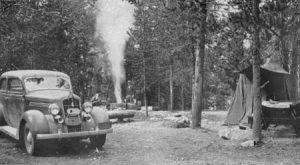
National-forest camps are located with regard to shade, scenery, and proximity to recreation areas.—Shoshone National Forest, Wyo. (F—385836)

